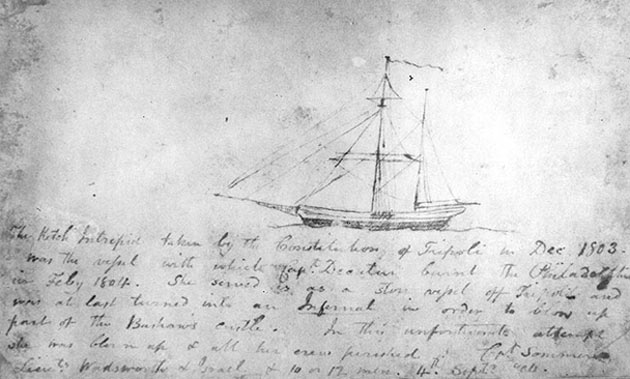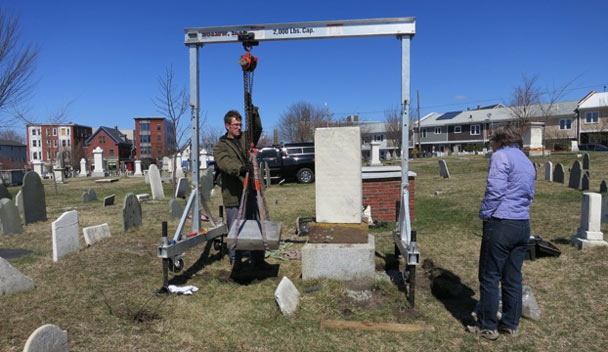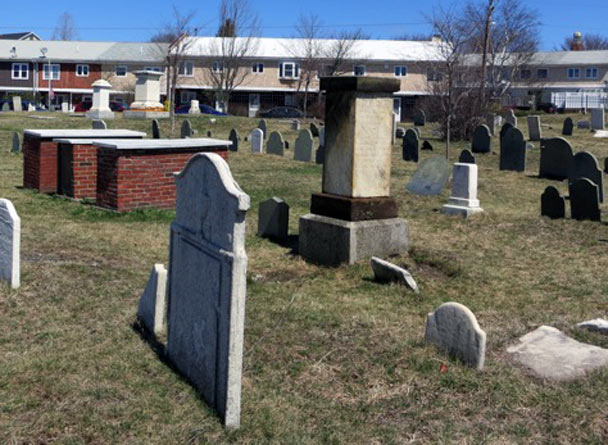Wadsworth Monument Repair
Lieutenant Henry Wadsworth was the son of Peleg and Elizabeth and the namesake of the poet, Henry Wadsworth Longfellow. He joined the U.S. Navy and served under Commander Edward Preble, and at age 20, he volunteered to serve upon the U.S.S. Intrepid.
Dragged Through the Streets
As part of the Barbary Wars, the Intrepid—captured from Tripoli and transformed into a U.S. Naval vessel—was sent into their harbor by Commander Preble loaded with explosives. The crew who included volunteer Lt. Wadsworth was to abandon ship before the explosion, because it was designed to dessimate Tripoli's vessels.1
Unfortunately, the enemy found out about this plan, and the Intrepid exploded prematurely. The morning after, the remains of the Intrepid's crew were dragged through the streets. They were eventually interred in the Old Protestant Cemetery,2 and efforts to repatriate them are ongoing.3

The U.S. Ketch Intrepid (1804) sketch by midshipman William Lewis in the possession of Captain C.W. Cook, 1925. Image from the U.S. Navy
That Life I Give to You
A cenotaph (empty tomb or monument erected in honor of someone who has died) was erected in the Eastern Cemetery. It is inscribed:
“In memory of Henry Wadsworth, son of Peleg Wadsworth, Esq., Lieut, in the U.S. Navy, who fell before the walls of Tripoli, on the evening of the 4th Sept. 1804, in the 20th year of his age, by the explosion of a fireship, which he with others gallantly conducted against the enemy; determined at once, they prefer death and the destruction of the enemy, to captivity and torturing slavery.
Capt. Richard Somers, Lieut. Henry Wadsworth, Lieut. Joseph Israel, and ten brave seamen volunteers were the devoted band.
An honor to his country, and an example to all excellent youth.
My country calls! This world adieu; I have one life, that life I give for you.” 4
Henry's sister, Zilpah (who named her son after him) penned an obituary for him; her grief is apparent as in this excerpt: “...Oh! My Brother! Thou art laid low. No funeral rites for thee! No afflicted mourners consign thee to the grave....” 5
After the Fall
The monument likely stood for over 200 years before it was toppled by uneven ground or possibly vandalism.
Proudly Standing Once Again
Thanks to the work of conservator Kai Nalenz of Gravestone Services of New England and a donation from Spirits Alive, the monument stands once again as a tribute to the life of a man who gave all for his country. On April 20, 2013, the stones were reuinited and righted using a tripod and good gravestone conservation techniques. The monument awaits the day that Lt. Wadsworth's remains can be interred in his hometown's oldest graveyard.

Kai Nalenz uses an apparatus to right the heavy marble, sandstone, and granite components of the monument. Photo by Barbara Hager.

The Wadsworth monument stands in full glory once again! Photo by Barbara Hager.
Special thanks to the city of Portland for allowing and partnering with Spirits Alive to continue to improve the situation of the stones and the acreage in the Eastern Cemetery.
1Wikipedia contributors. “USS Intrepid (1798).” Wikipedia, The Free Encyclopedia, 26 Mar. 2013. Web. 5 May 2013.
2Bill Kelly. “Latest Photo of Old Protestant Cemetery, Tripoli” Remember the Intrepid, January 16, 2013. Web. 5 May 2013.
3Riskind, Jonathan. Repatriation of Wadsworth Remains Foiled. Maine Sunday Telegram, December 1, 2011.
4Coolidge, Austin Jacobs and Masfield, John Brainard, A history and description of New England, general and local, Vol. 1: Maine, New Hampshire, and Vermont. A.J. Coolidge, 1859.
5D'Abate, Richard. “From the Collections: The Libyan Connection: Preble and Wadsworth in Tripoli.”Maine Historical Society member newsletter, Fall 2011.
